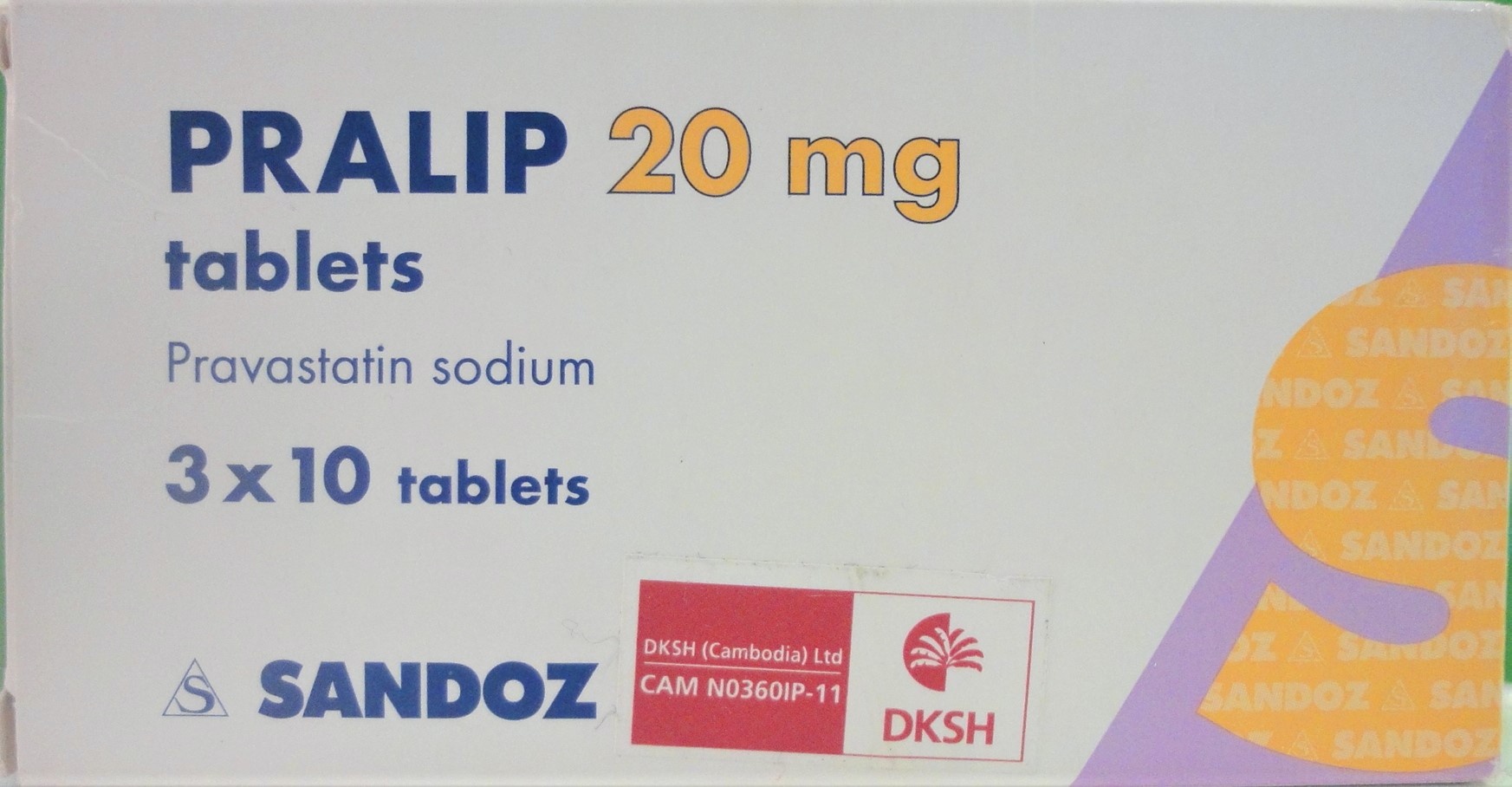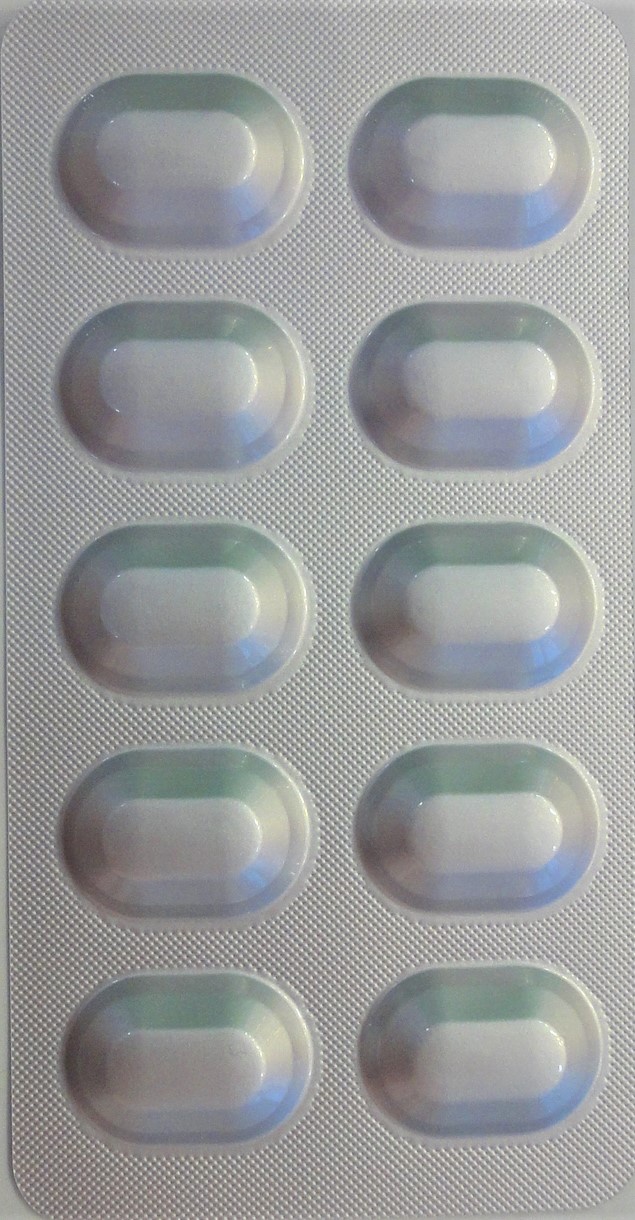PRALIP Tablet
ក្រុមហ៊ុនផលិតឱសថ:
Lek Pharmaceuticals, Slovenia
ក្រុមហ៊ុនចែកចាយឱសថនៅប្រទេសកម្ពុជា:
DKSH


- សារធាតុសកម្ម
- ប្រសិទ្ធិភាពព្យាបាល និង កម្រិតប្រើប្រាស់
- ហាមប្រើ
- ផលរំខាន
- អន្តរប្រតិកម្ម
- ស្ត្រីមានផ្ទៃពោះ និង ស្ត្រីបំបៅដោះកូន
- ការប្រុងប្រយ័ត្នជាពិសេស បរិយាយប័ណ្ណឱសថ
-
សារធាតុសកម្ម
Pravastatin sodium 20mg
-
ប្រសិទ្ធិភាពព្យាបាល និង កម្រិតប្រើប្រាស់
Indications:
Pralip belongs to a group of medicines called HMG-CoA reductase inhibitors (or statins) which work by reducing your body's production of “bad cholesterol” and raising the levels of "good" cholesterol. Cholesterol is a lipid that can cause coronary heart disease by narrowing the vessels that supply the heart with blood. This condition, called hardening of the arteries or atherosclerosis, may lead to chest pain (angina pectoris), a heart attack (myocardial infarction) or stroke.
If you have already had a heart attack or have chest pain at rest (unstable angina pectoris), Pralip reduces the risk of having another heart attack or stroke in the future, regardless of your cholesterol levels.
If you have raised levels of cholesterol but do not have coronary heart disease, Pralip reduces the risk of this occurring or of you having a heart attack in the future.
When you use Pralip, your doctor will recommend other actions as part of your treatment, such as a low-fat diet, exercise and weight reduction.
If you have had on organ transplant and are taking medication to stop your body rejecting the transplant, Pralip reduces increased lipid levels.
Dosage:
Always take Pralip exactly as your doctor has told you. You should check with your doctor or pharmacist if you are not sure.
Adults:
The usual dose of Pralip is 10-40mg once a day, preferably in the evening. Pralip can be taken with or without food, with half a glass of water.
Children and Adolescents (from 8 to under 18 years):
The recommended dose range of Pralip in children and adolescents between 8 and 13 years is 10-20 mg once a day. In children and adolescents between 14 and 18 years of age the recommended dose range of Pralip is 10-40 mg once a day.
Renal and hepatic impairment:
The usual dose is 10 mg once a day in patients with renal or hepatic impairment.
Following organ transplantation:
The usual dose is 20mg once a day.
Other medicines:
Pralip should usually be taken at least one hour before or four hours after you have taken the Colestyramin or Colestipol.
The usual dose for person who uses Ciclosporin or other immunosuppressive medicines is 20 mg once a day. If you have the impression that the effect of Pralip is too strong or too weak, talk to your doctor or pharmacist.
If you take more Pralip than you should:
If you have taken too many tablets, or if someone accidentally swallows some, contact your doctor or the nearest hospital for advice.
If you forget to take Pralip:
If you miss a dose do not worry. Simply take your normal dose when it is next due. Do not take a double dose to make up for forgotten individual doses.
If you stop taking Pralip:
Always tell your doctor if you want to stop the treatment.
If you have any further questions on the use of this medicine, ask your doctor or pharmacist.
-
ហាមប្រើ
Do not take Pralip:
• if you are hypersensitive (allergic) to any ingredient in Pralip;
• if you are pregnant or if there is a possibility that you may become pregnant;
• if you are breast feeding;
• if you have liver problems.
-
ផលរំខាន
Like all medicines, Pralip can cause side effects, although not everybody gets them.
Contact your doctor as soon as possible and stop taking Pralip if you develop any unexplained or persistent muscle pain, tenderness, weakness or cramps, especially, if at the same time you feel unwell or have a high temperature. In very rare cases this has progressed to become a serious and potentially life-threatening condition (called rhabdomyolysis).
You should stop taking Pralip and see your doctor immediately if you experience symptoms of angioedema, such as:
• swollen face, tongue or pharynx
• difficulty to swallow
• hives and difficulties to breathe
Most patients do not have side effects from Pralip; however, some patients may experience side effects.
Other possible side-effects:
Uncommon (affects 1 to 10 users in 1000):
• dizziness, headache, difficulty in sleep
• problems with sight such as blurred or double vision
• stomach and bowel problems such as indigestion, abdominal pain, the pain of heartburn, sickness, vomiting, diarrhoea or constipation and wind
• skin reactions such as itching and rashes, hives (urticaria) or scalp and hair problems including hair loss
• bladder problems (painful or frequent urination, having to pass water at night)
• sexual difficulties
• tiredness
• muscle and joint pain.
-
អន្តរប្រតិកម្ម
Taking other medicines
It is important that you inform your doctor if you are already being treated with any of the following:
• other cholesterol lowering drugs called fibrates (e.g. gemlibrozile, fenofibrate). The combination may increase the risk of side effects.
• medicines used to adjust or adapt the immune response, e.g. ciclosporin. The combination may increase the risk of side effects.
• the antibiotics erythromycin or clarithromycin (the combination may result in on increased risk of developing muscle problems)
• a resin-type lipid-lowering agent such as colestyramine or colestipol (Pralip should usually be taken at least one hour before or four hours after you have taken the resin. This is because the resin can affect the absorption of Pralip if the two medicines are taken too closely together).
Please tell your doctor or pharmacist if you are taking or have recently taken any other medicines, including medicines obtained without a prescription.
Taking Pralip with food and drink
Pralip con be token with or without food.
If you are not sure about this please follow your doctor's guidelines.
-
ស្ត្រីមានផ្ទៃពោះ និង ស្ត្រីបំបៅដោះកូន
Do not take Pralip:
• if you are pregnant or if there is a possibility that you may become pregnant;
• if you are breast feeding
Pregnancy:
You should not take Pralip during pregnancy. Doctors will take special care when prescribing this medicine to young women that might become pregnant and they will properly explain the potential risk associated with pravastatin therapy during pregnancy. If you have plans to become pregnant or if you have become pregnant, you should stop taking Pralip and inform your doctor immediately (see above).
Ask your doctor or pharmacist for advice before taking any medicine.
Breast-feeding:
You should not take Pralip during breast-feeding (see above), as Pralip passes into the mother's milk.
Ask your doctor or pharmacist for advice before taking any medicine.
-
ការប្រុងប្រយ័ត្នជាពិសេស
• Tell your doctor if you have ever had any of the following:
• Kidney disease or on underactive thyroid
• Alcohol problems (regularly drinking large amounts of alcohol)
• A hereditary muscle disorder in yourself or a blood relative
• Side effects affecting your muscles when toking another cholesterol-lowering medicine such as a statin or fibrate.
• If you have had a history of liver problems.
• If you have severe respiratory failure.
If you have suffered from any of these problems, your doctor will need to carry out a blood test before and possibly during Pralip treatment to assess your risk of muscle-related side effects. You may also need this blood test if you are aged older than 70 years.
Go back to your doctor as soon as possible to discuss your concerns and follow the advice given.
In children before puberty, the benefit/risk of treatment should be carefully evaluated by physicians before treatment initiation.
*ព័ត៌មានឱសថត្រូវបានរៀបរៀងដោយ អ៊ីម៉ាតុគឹ មេឌីក (ខេមបូឌា) ដោយផ្អែកលើប្រភពព័ត៌មានខាងក្រោម។ សម្រាប់ព័ត៌មានលម្អិត សូមស្វែងរកនៅក្នុងក្រដាសព័ត៌មាននៃឱសថនីមួយៗ ឬ សាកសួរទៅកាន់ក្រុមហ៊ុនឱសថឬតំណាងចែកចាយនៃឱសថនីមួយៗ។
ប្រភពព័ត៌មាន៖
- ក្រដាសព័ត៌មាននៃឱសថសម្រាប់អ្នកជំនាញវេជ្ជសាស្ត្រដែលប្រើប្រាស់នៅប្រទេសជប៉ុន (Pharmaceutical and Medical Devices Agency, Pmda): https://www.pmda.go.jp
- ព័ត៌មានសង្ខេបនៃឱសថសម្រាប់អ្នកជំងឺដែលប្រើប្រាស់នៅប្រទេសជប៉ុន: http://www.rad-ar.or.jp
